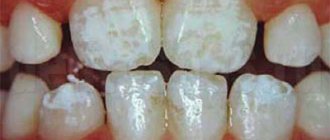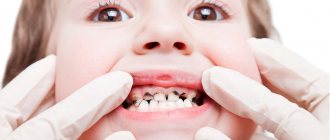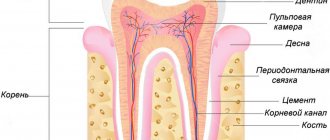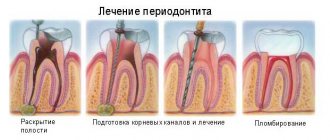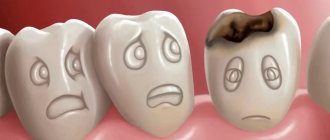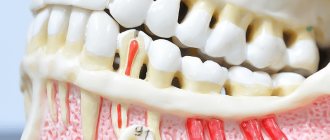Secondary caries is a new pathological process that occurs in the tissues of a tooth that has previously been subjected to dental treatment. Often, it appears due to insufficient antiseptic treatment of the carious cavity or poor-quality filling, but there may be other reasons, which we will discuss below.
Dental caries under a filling is characterized by a long asymptomatic course. The first symptoms may appear 2-3 years after the filling is installed: discoloration of the enamel and increased sensitivity of the tooth. In severe cases, pulpitis can develop, which can lead to serious consequences, including tooth loss and osteomyelitis of the jaw bone.
Causes of caries under fillings
As a rule, secondary caries is the result of a whole complex of different factors. Only a dentist can name the exact cause, based on medical history and examination of the unfilled tooth - after he sees what caries looks like under the filling and determines what factors could cause it.
Of particular importance in the formation of secondary pathology is the individual susceptibility of tooth tissue to caries, the composition of the filling material, as well as compliance with oral hygiene.
The main causes of caries under fillings:
- Application of high shrinkage fillings. Over time, such fillings reduce their volume in the carious cavity, which provokes detachment of the filling material from the edges of the hard tissues of the tooth. Bacteria penetrate into the spaces unfilled with a filling, provoking a new stage of caries development. Sometimes, caries damage can be seen with the naked eye along the edges of the filling, especially on the front teeth;
- Poor-quality cleaning of a carious cavity is a direct mistake by the doctor when filling: the affected tissue remains inside, in which bacteria are concentrated, continuing tooth destruction;
- Poor processing of the filling - rough grinding and polishing contribute to increased adhesion, which leads to accelerated plaque formation on the surface of hard tooth tissues, as well as the formation of chips of the filling material and microcracks.
Caries is a systemic disease that can occur not only due to the above reasons, but also due to general factors. For example, in regions of Russia with low fluoride content in the soil, more than 97% of the population (all age groups) suffer from primary and secondary caries. Also, the development of caries under a filling can be triggered by the patient’s refusal of immunomodulatory therapy during the treatment of concomitant diseases.
Key differences between secondary caries and recurrent caries
Unlike secondary caries, recurrent caries occurs only at the site of treatment already performed. If lesions appear on the same tooth, but nearby, this is repeated caries. It is almost impossible to find out the cause of the development of recurrent or repeated caries. Only a doctor, based on examination data, can suggest why caries appeared under the fillings.
When diagnosing secondary and recurrent caries, the doctor must remember that both types can develop in combination due to a combination of various factors.
Expert advice
The arrangement of teeth in a row was initially determined by nature, so the elements must touch correctly for the full implementation of the chewing function. A change in the bite can cause an incorrect distance between the jaws. Once such a pathology develops, it will be much more difficult for the doctor to eliminate it.
To minimize the likelihood of complications, the patient must take certain actions himself. If bite defects are observed within a few days after installing the composition, you should immediately consult a dentist. Correcting the filling will take a few minutes, but these manipulations will help prevent the development of disorders.
After installing the material, some people complain about roughness and stepped placement of the composition. Pathogenic microorganisms can accumulate in the formed cavities, which will lead to the development of secondary caries. In such cases, it is also necessary to urgently visit the dentist's office.
Category Dental filling Posted by Mister stomatolog
Symptoms of caries under a filling
In the vast majority of cases, secondary caries is asymptomatic. The first signs, with rapid development, may appear only 3-6 months after the filling is installed. If symptoms appear 2-4 weeks after filling, this is recurrent caries. It occurs due to improper treatment and can pose a serious threat to the tooth. To eliminate it, it is necessary to replace the old filling with repeated cleaning and disinfection of the carious cavity.
Classic symptoms of caries under a filling include:
- Darkening of the enamel near the edge of the installed filling - pigmentation can be located either at one edge or along the entire rim of the filling;
- The causative tooth acquires a gray tint, through the enamel you can see what caries looks like under the filling - it will have a dark tint;
- Chips of the filling and tooth enamel appear, microcracks form (not always);
- The mobility of the filling increases. With prolonged development of caries, it may fall out;
- There is an unpleasant odor from the mouth, caused by the proliferation of bacteria in the formed microcracks;
- Increased sensitivity of teeth to cold, hot, sour and sweet;
- Aching pain appears, which intensifies during the process of biting;
- Acute tooth damage by secondary caries develops, accompanied by pain, swelling and bleeding.
Symptoms and signs
Recognizing signs of tooth decay by caries is not so easy; a filling and the inconvenience of self-examination do not allow one to detect darkening of the enamel or the beginning destruction of bone tissue. However, there are symptoms by which you can recognize the presence of the disease:
- pain on individual teeth and the lower part of the jaw;
- inflammation of the gums in the area of the filled tooth, swelling;
- an unpleasant odor emanates from the mouth (if the tooth is rotting under a filling);
- the appearance of blood on the gums when brushing the mouth or as a result of a minor collision with blunt objects.
Bleeding from the gums of the affected tooth and aching in the jaw area are often observed. Carious lesions of bone tissue can also be detected visually. It is worth paying attention to the seal. Often it changes color or a dark brown rim appears along its edges. The formation of cracks and chips of tooth enamel is also observed.
Consequences of secondary caries
The lack of timely diagnosis and proper treatment leads to the development of complications in the form of acute or chronic tooth pulpitis with aching pain and all the ensuing consequences. At this stage, replacing the old filling with a new one, while simultaneously cleaning the carious cavity, will not help - preliminary treatment of pulpitis is necessary.
Delaying the treatment of pulpitis under a filling leads to partial or complete destruction of the hard tissues of the tooth. It is accompanied by the development of infection affecting the periodontal tissues with subsequent progression to periodontitis. In particularly severe cases, periodontitis affects the jaw bone - this can result in osteomyelitis of the jaw bone.
Methods for diagnosing and treating caries under fillings
It is quite difficult to determine the presence of secondary caries in the initial stages, due to the absence of symptomatic and visual manifestations. The disease is diagnosed during a follow-up appointment using diagnostic equipment (hardware diagnostics).
Diagnostics includes two stages:
- Anamnesis and initial examination of the causative tooth in order to detect visible structural changes in hard tissues;
- Hardware diagnostics (physiography) is aimed at detecting hidden changes in the structure of dental tissues.
If a pathology is detected, treatment is prescribed taking into account the individual characteristics of the patient.
Features of treatment of secondary caries
The use of one or another treatment regimen for secondary caries directly depends on the location of the lesion, its depth and the condition of the causative tooth. Treatment may include two options for developing the situation:
- Re-filling or replacing part of the filling in the affected area is performed only after treating the tooth and eliminating the carious lesion. In some cases, it may be necessary to remove the nerve and fill the canals.
- Surgical tooth extraction is used in extreme cases when the damage is too large and the doctor cannot save the affected tooth.
Treatment or removal - what determines the outcome
The doctor makes a decision on treatment or tooth extraction after determining the depth of spread and the area of localization of the inflammatory process. It is mandatory to first carry out professional cleaning using an ultrasonic scaler, an AirFlow water-abrasive device and hand tools.
Initial caries is treated with conservative retherapy. For hard tissue defects, preparation and filling are performed. In severe cases, the tooth is removed.
Treatment of the initial stage of root caries
Conservative retherapy includes:
- fluoridation of teeth;
- covering teeth with protective agents
- training in proper oral hygiene
Methods for preventing caries under a filling
High-quality prevention of secondary caries involves the elimination of complications at the stage of initial installation of a filling - the doctor must ensure the correct method of caries treatment, antiseptic treatment of the hole for the filling and installation of the filling.
On the patient’s side, the most effective prevention of secondary caries under a filling is maintaining proper oral hygiene, as well as systematic examinations in a dental clinic: a month after the filling is installed and at least 2 times a year thereafter.
Expanding indications for tooth filling
Many patients are surprised, and some are even outraged, by the dentist’s statements about the need to restore the tooth with a more reliable structure - a crown or inlay (onlay) instead of a filling. Misunderstanding leads to suspicion of the doctor of incompetence or of a “scam” for an expensive restoration. “Why can’t you build up a tooth with a filling?” — Those who previously had a filling in the same place for several years are sincerely indignant, especially. It comes to the point that the patient runs away to a neighboring clinic, where the “kind” doctor saves his tooth from having a crown (sometimes charging an amount for “building up” or “artistic restoration” that is not much different from laboratory restoration), and then, two years later, a filling falls out or breaks off again.
There are medical indications and contraindications. They do not depend on the wishes of the doctor or patient. For fillings, the indication for installation is minor tooth decay. As a first approximation, we can say: insignificant - this is less than half the volume of the crown part of the tooth (although in reality everything is somewhat more complicated - the area of the lost chewing surface is taken into account, whether the cusps or cutting edge are affected, whether caries extends under the gum, how difficult it is to restore contact points, etc. .). If the tooth is more damaged, a filling is contraindicated. Of course, you may be lucky and an extensive filling will remain on the tooth for many years, but retention in the tooth is not the only requirement for a filling. It must also restore chewing function, have a tight contact point (so that food does not get stuck between the teeth), etc.
The loss of the “seal on the pin” is a direct consequence of violations of the indications. At a minimum, the “filling on the pin” should be covered and protected by an artificial crown, and at maximum, the tooth may have been so destroyed that it was contraindicated to preserve it even then, before pinning.
Why do some dentists follow the patient’s lead and make his dream of growing a tooth without a crown come true, while others are stubborn and refuse to do so? No, not because the former are good, and the latter are evil and greedy. It’s just that the “rescuers of hopeless teeth” agree to the “tuft of wool”, only the patient stayed and did not run away to another doctor. In addition, fillings and crowns are often done by different specialists: a general dentist and an orthopedic dentist, respectively. Moreover, the treatment of caries is the domain of the therapist; he does not always want to send the patient to another specialist, depriving himself of his daily bread. This is where the fillings are made. Even for the entire tooth, any volume of filling can be sculpted.
In case of small chips of enamel on the cutting edge, the fillings do not hold well. In this case, filling is also contraindicated, but instead, you can simply grind the enamel without restoring anything.


